Jianzhong Shou
AttriPrompter: Auto-Prompting with Attribute Semantics for Zero-shot Nuclei Detection via Visual-Language Pre-trained Models
Oct 22, 2024



Abstract:Large-scale visual-language pre-trained models (VLPMs) have demonstrated exceptional performance in downstream object detection through text prompts for natural scenes. However, their application to zero-shot nuclei detection on histopathology images remains relatively unexplored, mainly due to the significant gap between the characteristics of medical images and the web-originated text-image pairs used for pre-training. This paper aims to investigate the potential of the object-level VLPM, Grounded Language-Image Pre-training (GLIP), for zero-shot nuclei detection. Specifically, we propose an innovative auto-prompting pipeline, named AttriPrompter, comprising attribute generation, attribute augmentation, and relevance sorting, to avoid subjective manual prompt design. AttriPrompter utilizes VLPMs' text-to-image alignment to create semantically rich text prompts, which are then fed into GLIP for initial zero-shot nuclei detection. Additionally, we propose a self-trained knowledge distillation framework, where GLIP serves as the teacher with its initial predictions used as pseudo labels, to address the challenges posed by high nuclei density, including missed detections, false positives, and overlapping instances. Our method exhibits remarkable performance in label-free nuclei detection, outperforming all existing unsupervised methods and demonstrating excellent generality. Notably, this work highlights the astonishing potential of VLPMs pre-trained on natural image-text pairs for downstream tasks in the medical field as well. Code will be released at https://github.com/wuyongjianCODE/AttriPrompter.
Nucleus-aware Self-supervised Pretraining Using Unpaired Image-to-image Translation for Histopathology Images
Sep 14, 2023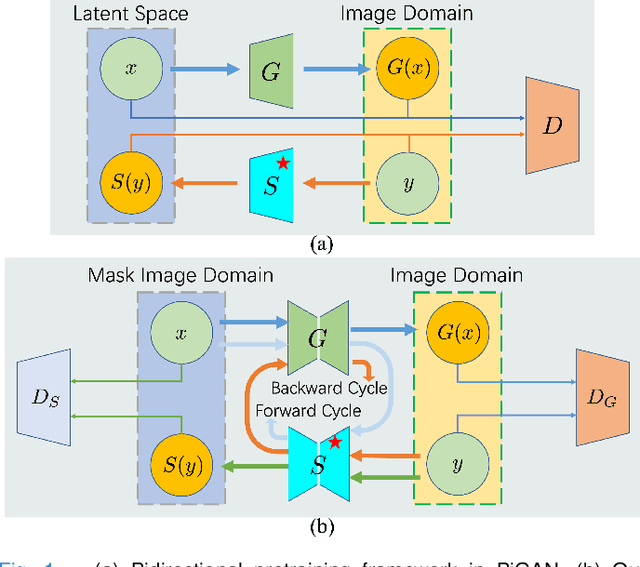
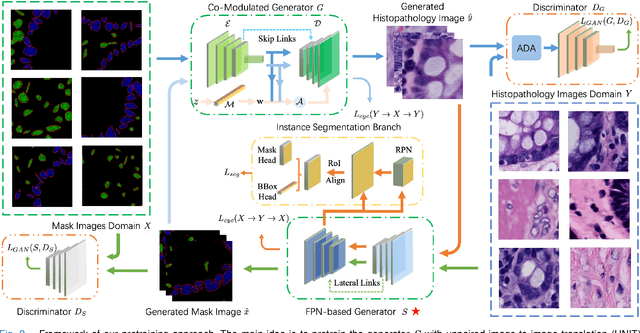
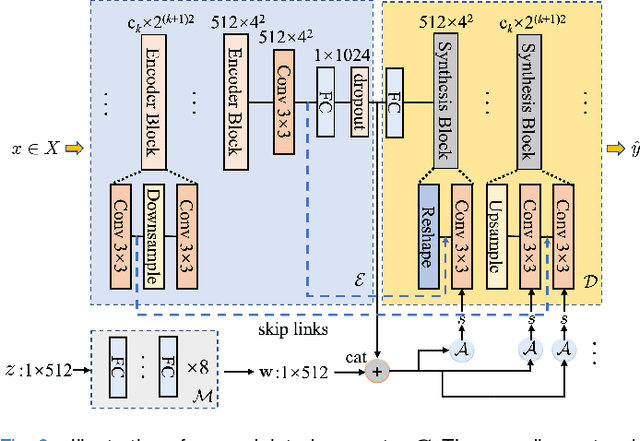
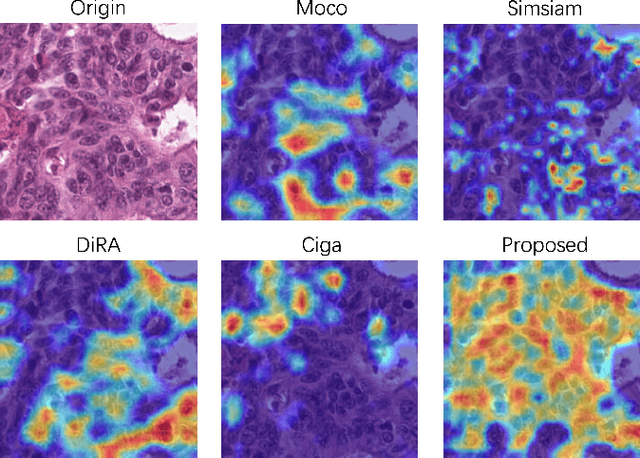
Abstract:Self-supervised pretraining attempts to enhance model performance by obtaining effective features from unlabeled data, and has demonstrated its effectiveness in the field of histopathology images. Despite its success, few works concentrate on the extraction of nucleus-level information, which is essential for pathologic analysis. In this work, we propose a novel nucleus-aware self-supervised pretraining framework for histopathology images. The framework aims to capture the nuclear morphology and distribution information through unpaired image-to-image translation between histopathology images and pseudo mask images. The generation process is modulated by both conditional and stochastic style representations, ensuring the reality and diversity of the generated histopathology images for pretraining. Further, an instance segmentation guided strategy is employed to capture instance-level information. The experiments on 7 datasets show that the proposed pretraining method outperforms supervised ones on Kather classification, multiple instance learning, and 5 dense-prediction tasks with the transfer learning protocol, and yields superior results than other self-supervised approaches on 8 semi-supervised tasks. Our project is publicly available at https://github.com/zhiyuns/UNITPathSSL.
Zero-shot Nuclei Detection via Visual-Language Pre-trained Models
Jun 30, 2023Abstract:Large-scale visual-language pre-trained models (VLPM) have proven their excellent performance in downstream object detection for natural scenes. However, zero-shot nuclei detection on H\&E images via VLPMs remains underexplored. The large gap between medical images and the web-originated text-image pairs used for pre-training makes it a challenging task. In this paper, we attempt to explore the potential of the object-level VLPM, Grounded Language-Image Pre-training (GLIP) model, for zero-shot nuclei detection. Concretely, an automatic prompts design pipeline is devised based on the association binding trait of VLPM and the image-to-text VLPM BLIP, avoiding empirical manual prompts engineering. We further establish a self-training framework, using the automatically designed prompts to generate the preliminary results as pseudo labels from GLIP and refine the predicted boxes in an iterative manner. Our method achieves a remarkable performance for label-free nuclei detection, surpassing other comparison methods. Foremost, our work demonstrates that the VLPM pre-trained on natural image-text pairs exhibits astonishing potential for downstream tasks in the medical field as well. Code will be released at https://github.com/wuyongjianCODE/VLPMNuD.
Cyclic Learning: Bridging Image-level Labels and Nuclei Instance Segmentation
Jun 05, 2023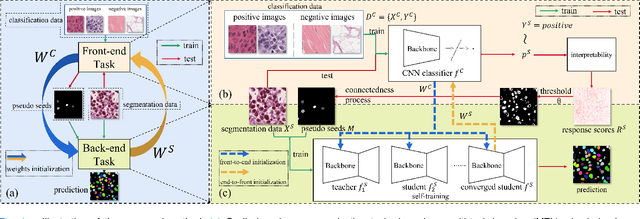

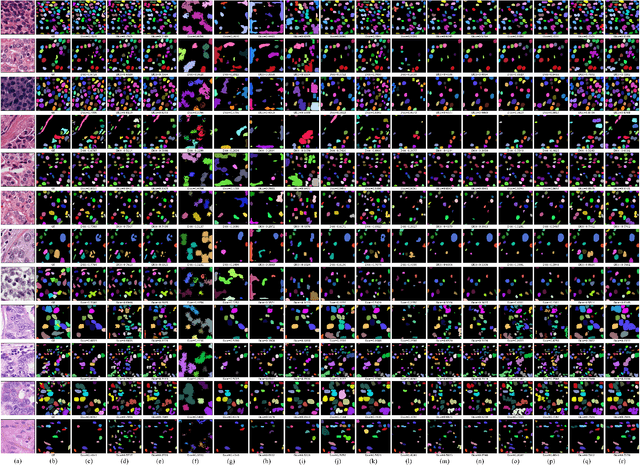
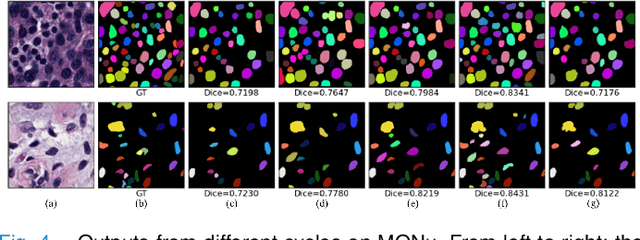
Abstract:Nuclei instance segmentation on histopathology images is of great clinical value for disease analysis. Generally, fully-supervised algorithms for this task require pixel-wise manual annotations, which is especially time-consuming and laborious for the high nuclei density. To alleviate the annotation burden, we seek to solve the problem through image-level weakly supervised learning, which is underexplored for nuclei instance segmentation. Compared with most existing methods using other weak annotations (scribble, point, etc.) for nuclei instance segmentation, our method is more labor-saving. The obstacle to using image-level annotations in nuclei instance segmentation is the lack of adequate location information, leading to severe nuclei omission or overlaps. In this paper, we propose a novel image-level weakly supervised method, called cyclic learning, to solve this problem. Cyclic learning comprises a front-end classification task and a back-end semi-supervised instance segmentation task to benefit from multi-task learning (MTL). We utilize a deep learning classifier with interpretability as the front-end to convert image-level labels to sets of high-confidence pseudo masks and establish a semi-supervised architecture as the back-end to conduct nuclei instance segmentation under the supervision of these pseudo masks. Most importantly, cyclic learning is designed to circularly share knowledge between the front-end classifier and the back-end semi-supervised part, which allows the whole system to fully extract the underlying information from image-level labels and converge to a better optimum. Experiments on three datasets demonstrate the good generality of our method, which outperforms other image-level weakly supervised methods for nuclei instance segmentation, and achieves comparable performance to fully-supervised methods.
 Add to Chrome
Add to Chrome Add to Firefox
Add to Firefox Add to Edge
Add to Edge